by Ivary & Paola | Nov 2, 2019 | 4th/5th Grade News
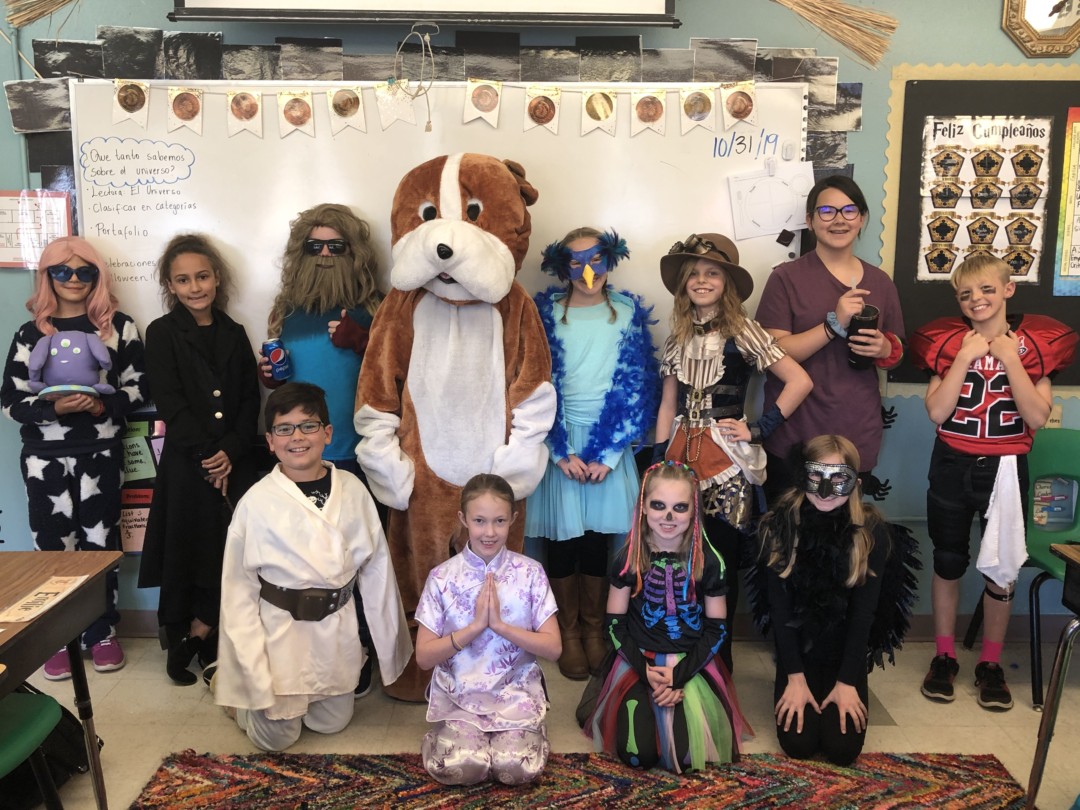
Happy Halloween!
History & Geography
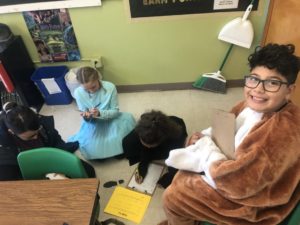
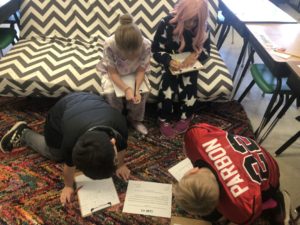 This week we continued to learn about the Age of Exploration. Our objectives were:
This week we continued to learn about the Age of Exploration. Our objectives were:
- begin our history poster project: students will read a chapter in pairs and create a poster describing important events and people from that chapter
- Describe the effects of Spanish colonization on the indigenous peoples of the Americas, including
the encomienda system
- Summarize the journeys of Hernán Cortés, Francisco Pizarro, and Vasco Núñez de Balboa
- Summarize the viewpoints and impact of Bartolomé de Las Casas
Mathematics
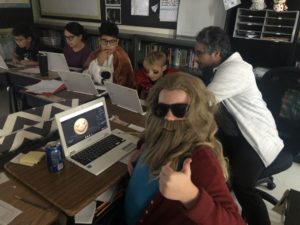 This
This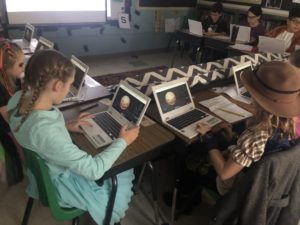 week we began learning about Fractions and Mixed Numbers. Our objectives were:
week we began learning about Fractions and Mixed Numbers. Our objectives were:
- use the Least Common Multiple to change fractions so that they have common denominators
- add and subtract unlike fractions
- practice adding and subtracting unlike fractions by completing a Harry Potter escape room
- estimate adding and subtracting fractions using benchmarks (0, 1/2, 1)
- change division expressions to fractions
Lectura y Ciencias
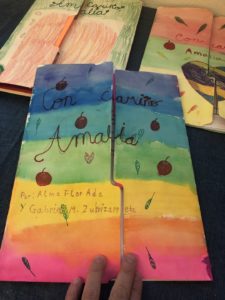
This week we continued to work on the final pieces of our portfolio, Con carino Amalia.
This week we started unit 2, Our Corner of the Universe. Some of the essential questions for this unit include: What is our place in this vast universe? How much do we know about it? Through the study of a variety of genres and mediums, we will explore this fascinating topic. Students will have the opportunity to raise their own questions and go through and inquiry process to find answers and/or explanations. This week we read the expository piece, El universo. After reading, we applied to skill of organizing information into different categories. Lastly, we finished our solar system art project. When working on this project, we had an opportunity to use the science vocabulary in Spanish.
Some of the objectives for this week included:
- Establish purposes, audiences and the need for different genres: expository and fiction, for example.
- Establish the purpose and audience to write an expository writing piece: Un articulo de revista.
- Apply reading comprehension skills and strategies (making connections, clarifying, visualizing)
- Understand the spelling patterns of words with h.
- Learn how to use relative pronouns in context.
- Apply knowledge of the use of capitalization and proper punctuation.
- Compare and contrast two objects or ideas, in oral and written for. Demonstrate understanding of how to compare and contrast texts.
- Cross-check different sources of information.
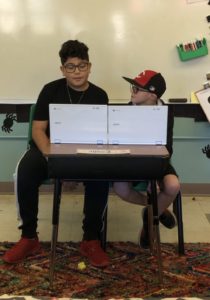
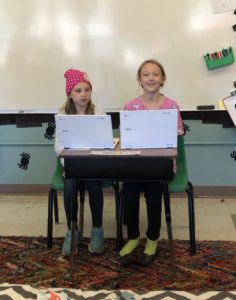
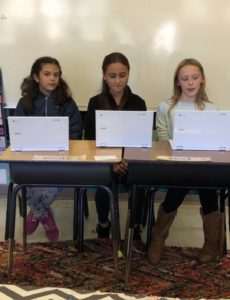
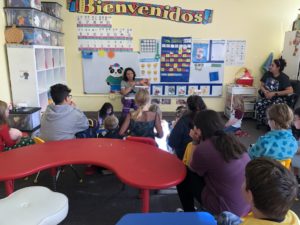
Visiting the Preschool class to hear Miss Macky’s presentation about one of Mexico’s most sacred traditions, El día de los muertos.
Specialists
Art with Ms. Kelly
Apples Paintings
- Observe shape, color and texture of real apples
- Learn about our state’s apple orchards
- Look at Paul Cezanne’s paintings of fruit
- Draw overlapping apples on a plate (aerial view) or in a bowl (side view)
- Use only red, blue, yellow and white to mix a variety of colors
- Each class from K through 4th/5th made stunning apple paintings!
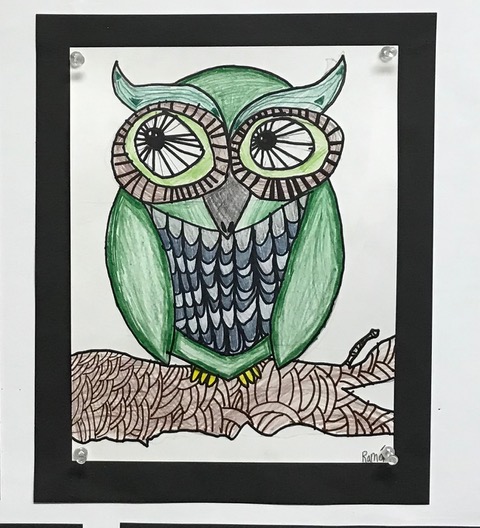 Owl Drawings
Owl Drawings
- Thank you Kate Westfall for sharing this great project from your teacher at Prune Hill Elementary!
- Look at photos of real owls
- Follow a Directed Drawing of a Great Horned Owl
- Use markers and colored pencils to create color, pattern, and value (shading)
- These beautiful owls are on the bulletin board at school!
Pumpkins and Still Life Art Project
- Choose 3 different art styles to create 3 still life pictures
- Look at still life art by Henri Matisse, Pablo Picasso, Georgia O’Keefe, Jackson Pollock
- Use a variety of techniques to add color and texture
- Some of these very creative Still Life projects will be on the bulletin board next week, and we’ll continue this project in November.
Ginkgo Leaf Rubbings
- Thank you Ms. Laura for gathering all these beautiful leaves for our art projects!
- Learn about ginkgo trees
- Incorporate ginkgo leaves into your still-life designs
Music with Ms. Nadia
Wow, has it been two months already?! This month flew by as we learned about the treble clef, triplets, and Beethoven.
At the end of September, each student chose a song to incorporate into our class. Each week I pick one to pair with an activity. This month we played a game of Old Town Road Madlibs, participated in an active drawing activity to I Can Only Imagine, performed House Party using everyday objects as percussion instruments, and beat drums to Don’t Let Me Down in a lesson about triplets. We learned the difference between pitched-percussion and non-pitched percussion as we played the notes of the treble clef on handbells and the glockenspiel. On music staff whiteboards, we practiced drawing treble clefs and notes on the staff. This is all in preparation for this coming month, in which we will learn the recorder!
Beethoven was a remarkable composer whose music expressed intense emotion. While he composed 9 symphonies, we focused on Beethoven’s 5th. Through drumming out the rhythm, we engaged the piece and learned the difference between a triplet and three eight notes with a rest (Beethoven used the latter). In a game of Two Truths and a Lie, we learned that Beethoven wrote a song for Napoleon, but scratched out the title once Napoleon made himself emperor. We also learned that Beethoven’s birthplace has been turned into a museum, and music saved his life. There are many epic arrangements of his 5thsymphony we enjoyed listening to, from acoustic guitar to metal, jazz to rock. I encourage everyone to keep exploring Beethoven’s symphonies!
Other class highlights include our improv games of Emotion Choir and Sound-ball.
Character Education
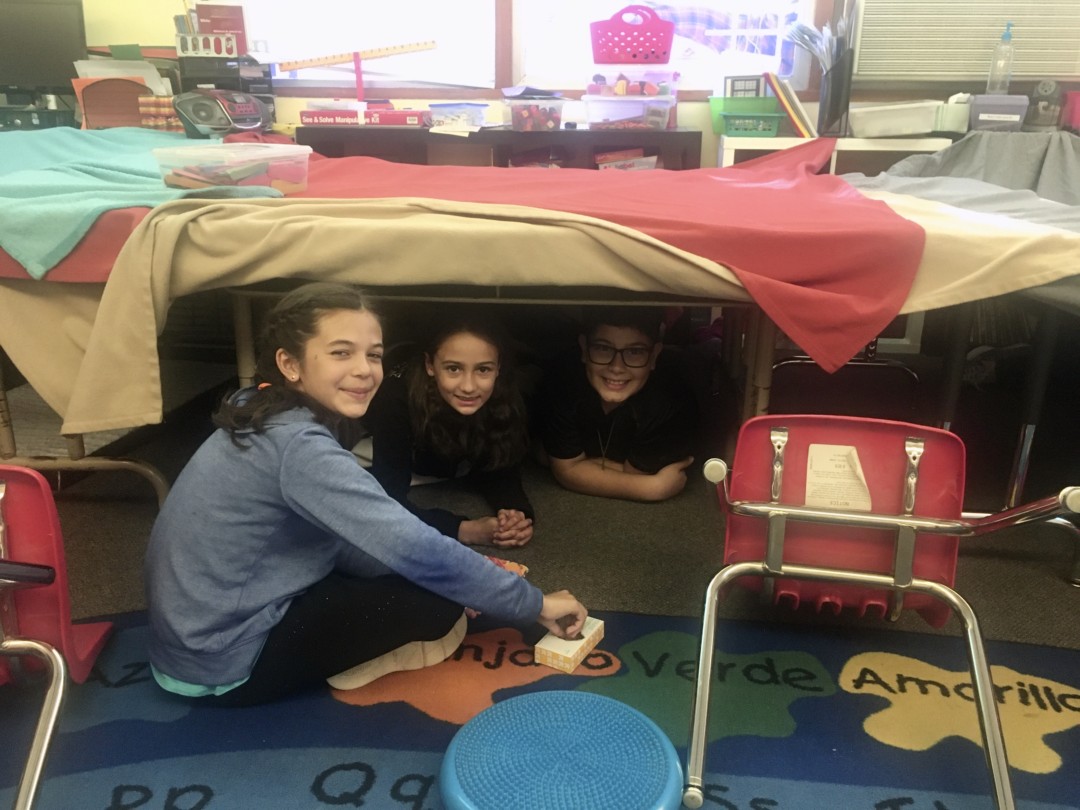
Stem-building under our blanket forts.
We had a great time with all our team building – cooperative activities throughout the month. We really learned the value of sharing our ideas, listening to other’s ideas, and making a plan that everyone agrees on.
by Marci & Ivary | Oct 26, 2019 | First Grade News
La Lectura
This week we read El gusanito de seda. Our objectives were:
•practice the comprehension skill: Visualization, during our 1st read
•identify the main idea and details within our story
•add and delete target sounds to change words
•blend phonemes into recognizable words
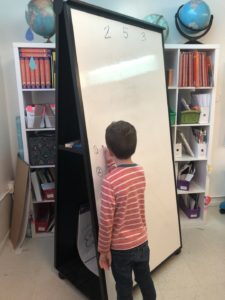 Las matemáticas
Las matemáticas
This week we finished our chapter on Subtract through 10. Our objectives were:
•write subtraction sentences
•solve real world problems
•write fact families
•use fact families to solve real world problems
Science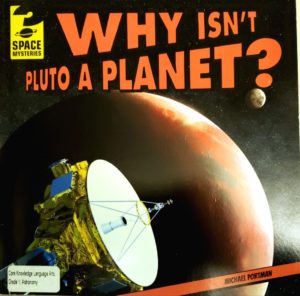
This week in our Astronomy domain we continued to work on the solar system flip books. We tried some real astronaut food, reviewed our lessons and took an assessment.
Our weekly objectives were to:
• identify Earth as a planet and our home
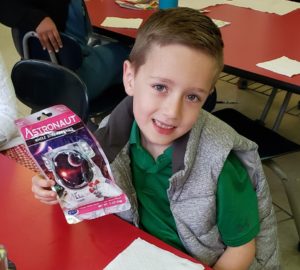
Astronaut sundaes
• classify the sun as a star
• understand that Earth orbits the Sun
• explain that our solar system includes the sun and the planets that orbit around it
• indicate that there are eight planets (Mercury, Venus, Earth, Mars, Jupiter, Saturn, Uranus, and Neptune)
• understand that Pluto has been reclassified as a dwarf planet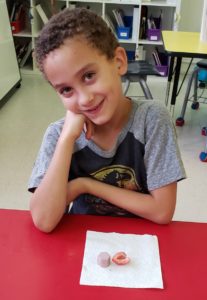
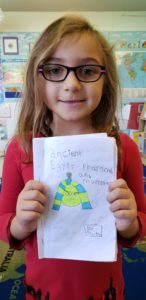
An independent project at home inspired by what I learned in class.
History & Geography
This week in our Ancient Egyptian studies we read trade books about Ancient Egypt and its gods, goddesses, and pharaohs. The class worked on a writing assignment that shares some of what they have learned. We also made egyptian collars and discussed Market Day. Your child should have come home with a note about Market Day, Tuesday Oct. 29. They should be bringing 10 items to trade with at the Market.
Our weekly objectives were to:
• locate Egypt on a world map or globe, and identify it as part of Africa
• describe key components of a civilization, with a emphasis on religion
• review what we have learned so far.
English Sight Words of the Week
made, make, many, may, more, me, my
by Jackie & Marci | Oct 26, 2019 | Kindergarten News
La Lectura
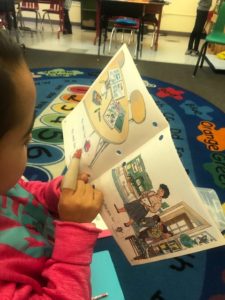 This week we read two books that talk about friendship and how important it is to make friends. “Ginger” (Ginger the cat) and “En busca de amigos” ( Looking for friends). In order to focus student’s attention and help them in their development of reading comprehension, they were asked questions which they had to answer at the end of the book. It was a very fun way that kept them paying attention while the book was read, and everyone wanted to answer the questions!
This week we read two books that talk about friendship and how important it is to make friends. “Ginger” (Ginger the cat) and “En busca de amigos” ( Looking for friends). In order to focus student’s attention and help them in their development of reading comprehension, they were asked questions which they had to answer at the end of the book. It was a very fun way that kept them paying attention while the book was read, and everyone wanted to answer the questions!
We did a small review of words that indicate measures: Largo (long) mas largo (longer) alto (tall) mas alto (taller) corto (short) bajo, foot, inch, yard.
We continued learning new words to expand their vocabulary so they will be able to make sentences in Spanish. This week the words of the day were: Y(and), a (to).
This week we reviewed all the initial sounds of the alphabet and began with the process of blending. Blending makes up the second component of the program Estrellita. This activity covers the syllables and the blending of those syllables to form words, sentences and short stories. We started the blending with the letter “A” (ma, pa, sa, la, etc.)
Practice in reading is critical to building fluency; learning to read is like learning to play a musical instrument, the more you practice, the better you get. For beginning readers, tracking the words with their index finger helps them focus on what they are reading and helps keep them on task, for this I told the children that this finger is called “el dedo mágico” (the magic finger) because it helps them to read. They should use it to point to words as they read them. To that end and make it more fun we gave them a plastic finger with a long fingernail, it was a very motivating way for them to have fun during reading time. For this activity, we read a book that focuses on the letter a: Papá, mamá y Ana. (Dad, Mom and Ana). They took turns using the magic finger to read in front of their classmates.
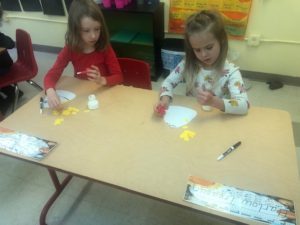
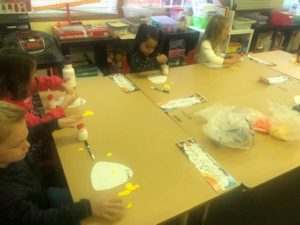
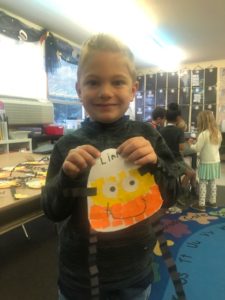
The fall craft of the week was a fun candy corn paper people, the kids loved making it!
Las matemáticas
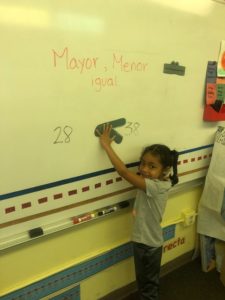
28 es menor que 38
The numbers of the week were 34-38 learning stroke, quantity and if it is even or odd. We did a fun activity with crocodiles to know which number is greater than (mayor que), less than (menor que) or equal (igual).
We continued with the learning of the ones (unidades) and tens (decenas), for which we did different activities with illustrated cards and lego blocks. These activities allowed us to introduce children to sums, for which they performed different exercises with dominoes, fingers and block. Some of these math activities coming with a fall theme. This week we have a new activity to learn counting in multiples of 10.
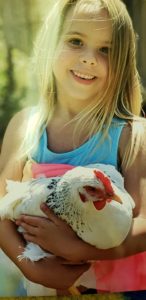
My farm
Science
This week we reviewed what we have learned so far and took our farm assessment. We did several activities centering around the farm, including a farm counting book and a barn writing activity.
Our weekly objectives were to:
• describe the farmers job
• explain why farms are important
• review what we have learned about farms and farm animals
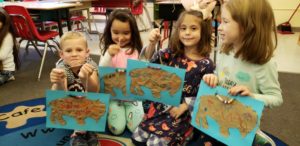
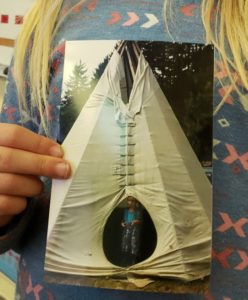
Sharing personal experiences
History & Geography
This week in we continued to learn about the Great Plains Native American Sioux tribe. The class finished their buffalo hide drawings and made parfleche, which they read about in one of our stories this week.
Our weekly objectives were to:
• identify the environment which the Sioux lived
• identify the Sioux as a nomadic tribe
• describe the food, clothing, and shelter of the Sioux
English Sight Words of the Week
brown, ten, three, five, six, seven, eight, nine
by Jill & Sarah | Oct 26, 2019 | 2nd/3rd Grade News
La Lectura
This week we are really focusing on our reading fluency, what this means, and how we can improve it as a whole class.
The Common Core State Standards, adopted by most states, require third-grade students to “read with sufficient accuracy and fluency to support comprehension.” Children must balance punctuation cues, phrasing, pace and expression to develop reading fluency. They also need to acquire a strong base of sight words. When students can read smoothly and accurately, and they transfer the skill to silent reading, comprehension increases.
All students were assess on 169 Spanish sight words and they all did a fantastic job! They know them very well! Now we are continuing to work on our reading strategies, identifying main idea and supporting details. I am finding the online reading (where they record their Spanish reading) very helpful. Please try to have your child read aloud each day and do at least one recording on the site each week.
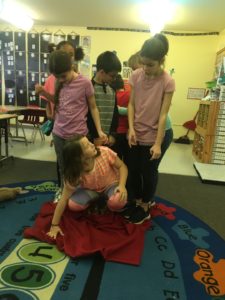
Teamwork: cooperation makes tasks possible in this ‘flip the blanket’ activity.
Las matemáticas
We have completed our addition within 10,000 unit and will add in subtraction next week. We have continued to have our daily 2-minute timed tests for addition. Students are doing very well! (Please get those flashcards out if your child comes home with a test below 45 correct.)
This week we practiced making our own addition word problems. Understanding how to make the story problems is very helpful when they read other problems.
I’d love for the students to bring their Halloween candies to school next Friday so we can use them to make some more addition and subtraction stories. This will be fun!
Science
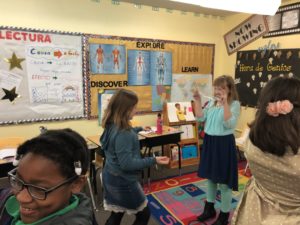
An experiment with reflexes. Learning about our nervous system.
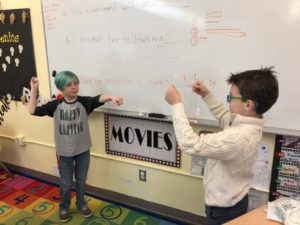
Our main goals this week were to:
- Explain that one of the systems of the human body is the nervous system and identify its function
- Identify the brain and spinal cord as the control center of the body
- Identify nerves as messengers that transmit information from all of the parts of the body through the spinal cord to the brain
- Explain that the five senses work with the brain to process information about our surroundings
- Describe a reflex action as a quick, unconscious action and explain its purpose in protecting the human body
- Identify parts of the brain: brain stem (medulla, cerebrum and cerebellum
- Describe the human brain as divided into two hemispheres
History & Geography
This week our objectives were to:
- Explain why Rome was considered a civilization
- Compare and contrast the three categories of people in ancient Rome: patricians, plebians, and slaves
- Describe the evolution of government in ancient Rome: monarchy to republic to empire
- Describe the senate as part of the government of the Roman Republic
- Describe the importance of forums in Roman society and government
- Identify some of the contributions from the ancient Roman civilization
- Identify and locate on a map the following: Mediterranean Sea, Italy, Sicily, North Africa, Carthage, Spain and the Alps
- Explain the significance of the Punic Wars
- Describe the role of Hannibal in the Punic Wars
by Ivary & Paola | Oct 26, 2019 | 4th/5th Grade News
History & Geography
This week we continued to learn about the Age of Exploration. Our objectives were:
• Describe the impact of Columbus’s voyage on the Taínos people.
• Summarize the terms of the Treaty of Tordesillas.
• Add Columbus’ voyage to our class map.
• Review what we’ve learned so far this unit by playing quizlet.
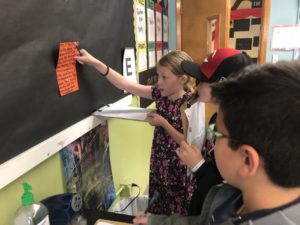 Mathematics
Mathematics
This wee we finished our chapter on multiplication and division. Our objectives were:
•Use effective strategies to solve multi-step problems.
•Participate in a math scavenger hunt to review for the test.
•Demonstrate mastery and understanding on the chapter test.
•Create a fall leaf color-by-number order of operations review.
Lectura
Unit 1 has come to an end. This week we spent time working on our unit review. After that, students took their end of the unit assessments. Now we are ready to dig into Unit 2, Our Corner of the Universe, which is closely connected to our science studies. We also had time to continue to make progress on our expository writing pieces. We will be ready to see the published pieces next week. In spelling, we studied homophones.
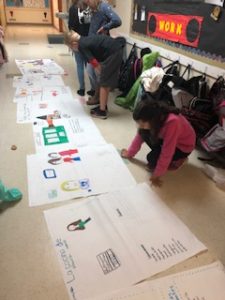
Book Club Gallery
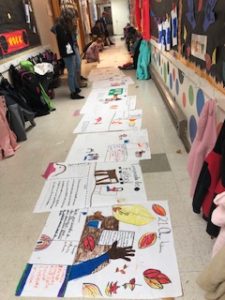
Con carino Amalia – galeria del club de lectores 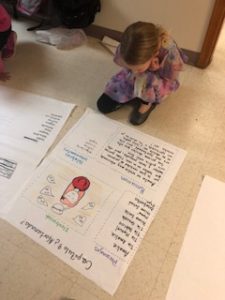
Ciencias
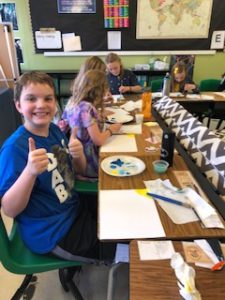
Solar System Art Project
Focus question: How do the parts of the solar system interact?
This week we took a close look at the parts that form our Solar System. We studied, compared and contrasted the characteristics and conditions of each planet, as well as others parts such as asteroids, moons, etc. Students modeled the concept of orbit and the gravity effect using a ball swinging in a circle on the end of a string. Gravity was introduced as the force that changes the planets’ direction of travel and produces circular orbits.
The solar system includes a star, the Sun, and the objects that orbit it, including Earth, the Moon, seven other planets, their satellites, and smaller objects.
The pulling force of gravity keeps the planets and other objects in orbit by continuously changing their direction of travel.
by Macky & Veronica | Oct 26, 2019 | Preschool
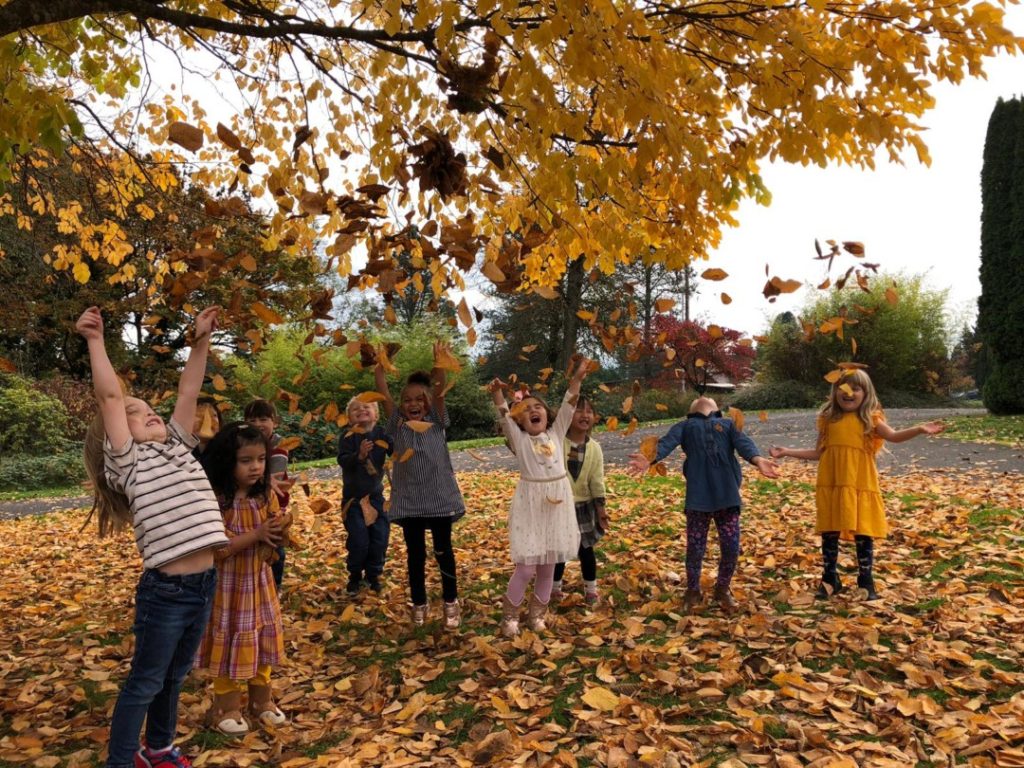
This week we continued working with “The Five Senses” / “Los Cinco Sentidos”. We focused on the sense of touch (tacto) and sense of hearing(oído)
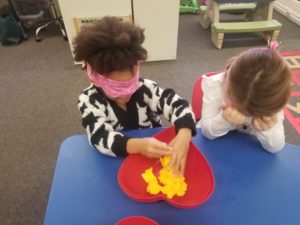 Sense of touch The kiddos did a god job feeling different materials and textures such as fleece, rocks, sandpaper, cotton, silk paper, sand, beans, playdough, slime, noodles, jelly. We read about different ways that we used the sense of touch; they had a great time doing a texture book and playing textures games. This experience encourages the kids to explore various textures and at the same time promotes observation plus expressive and descriptive vocabulary.
Sense of touch The kiddos did a god job feeling different materials and textures such as fleece, rocks, sandpaper, cotton, silk paper, sand, beans, playdough, slime, noodles, jelly. We read about different ways that we used the sense of touch; they had a great time doing a texture book and playing textures games. This experience encourages the kids to explore various textures and at the same time promotes observation plus expressive and descriptive vocabulary.
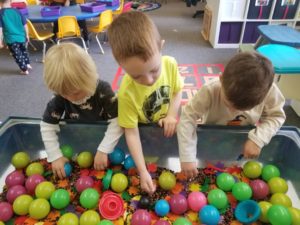
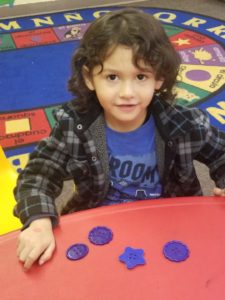
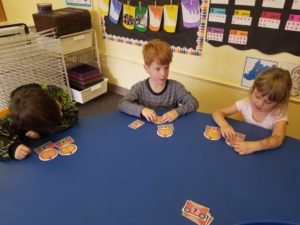
Sense of hearing The little ones learned that we use our ears to take in information about things around us. We used listening games and listened to different instruments. The kids heard sounds from different objects and then I asked them to name the object making the sound, We also did this with different animal sounds and then they had to guess what animal it was. Then the kiddos made different sounds and the teacher had to guess!! The kiddos sang los cinco sentidos and la araña pequeñita while we were varying the volume of our voice.
Kids had a great learning week with us
Libros
El Tacto
El oído
Letra
Las vocales

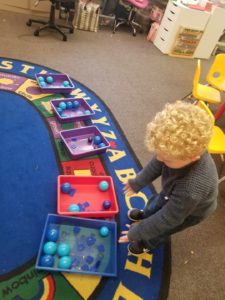 Número
Número
4
Fígura
Cuadrado
Color
Azul
Have a great weekend!
by Sarah Segall | Oct 19, 2019 | 2nd/3rd Grade News, 4th/5th Grade News, First Grade News, In The Loop, Kindergarten News, Preschool
What a fabulously fun week that our SPA (Spanish Parent Association) put together for us. The kids (and teachers) had such a fun week and we are SO appreciative of all the hard work and organization that was clearly put into the week. What a great way to show the kiddos how teamwork and cooperation can make wonderful things happen.
Thank you SPA!!!
-
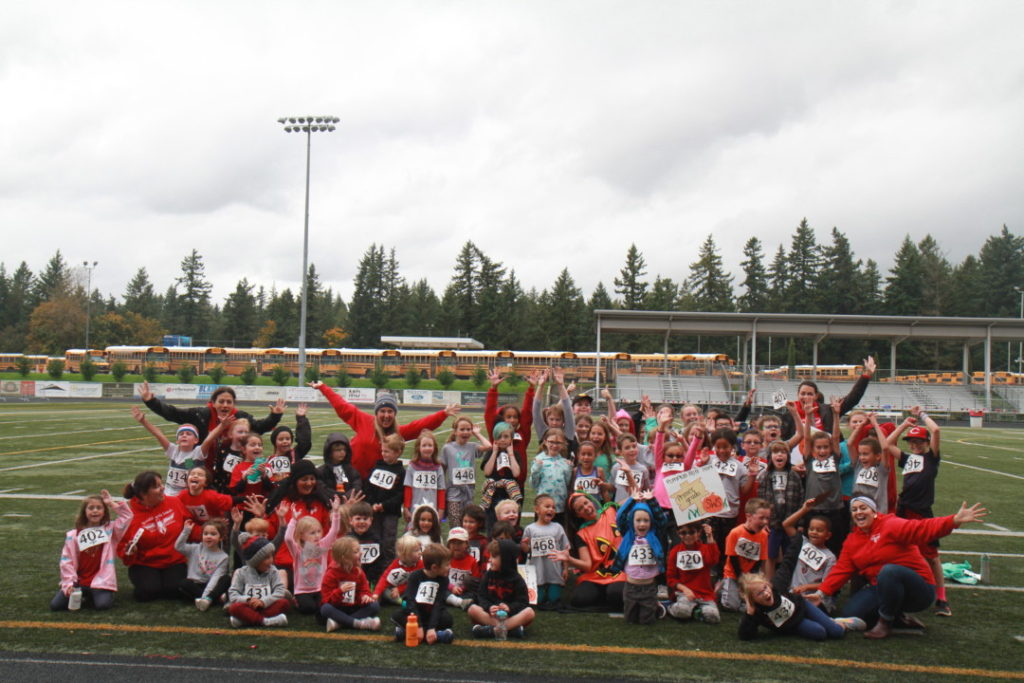
-
Pumpkin Fun Run
-
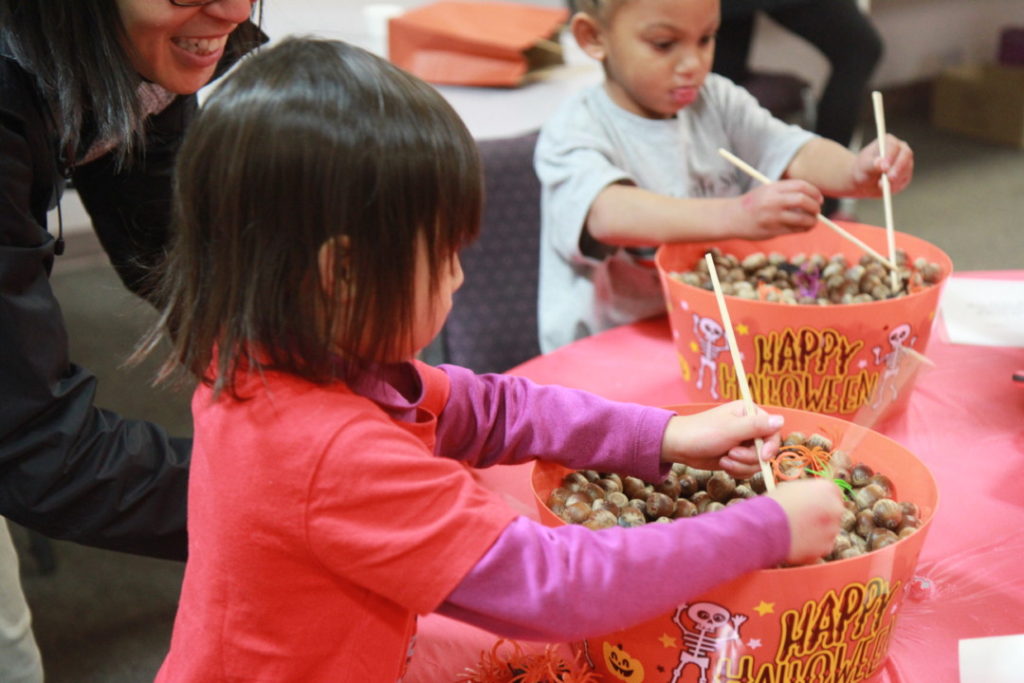
-
Preschoolers compete in the Spider Race
-
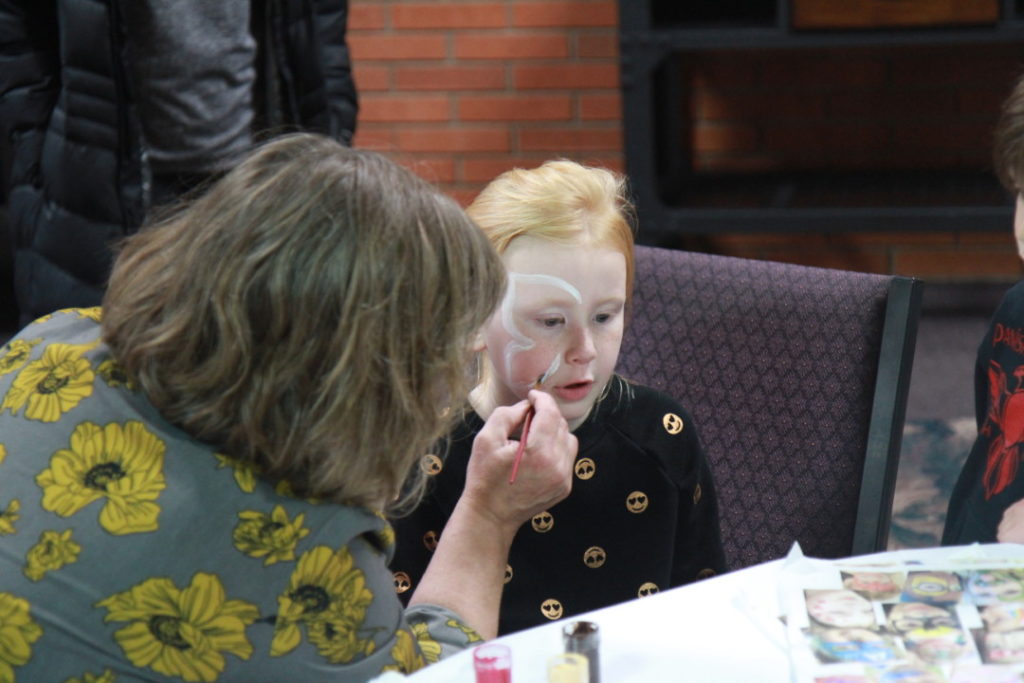
-
Face Painting
-
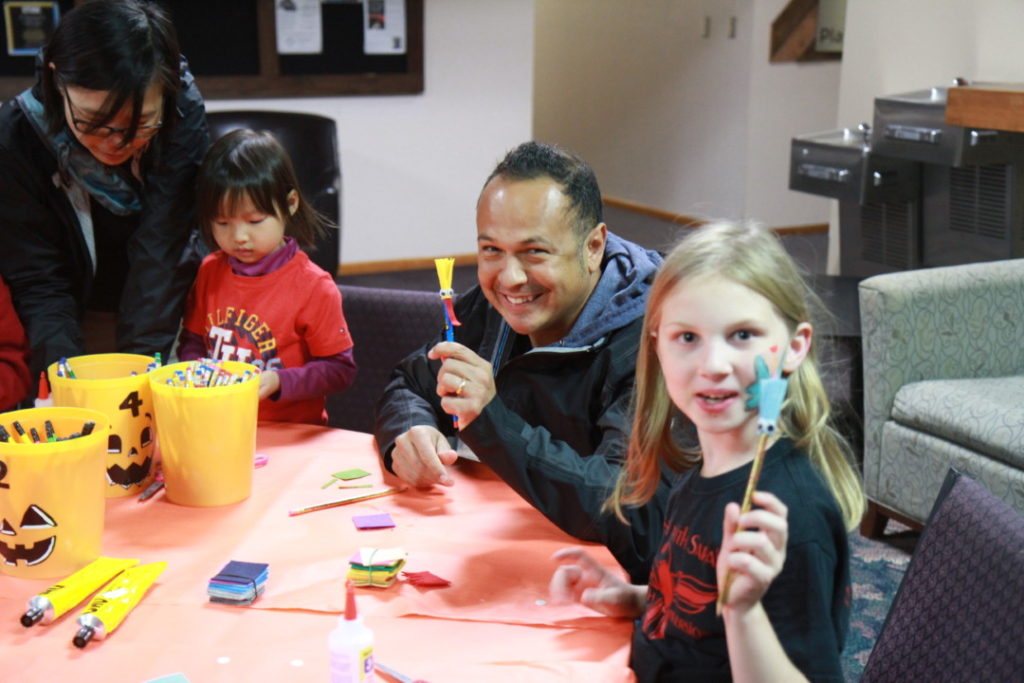
-
Monster Pencils
-
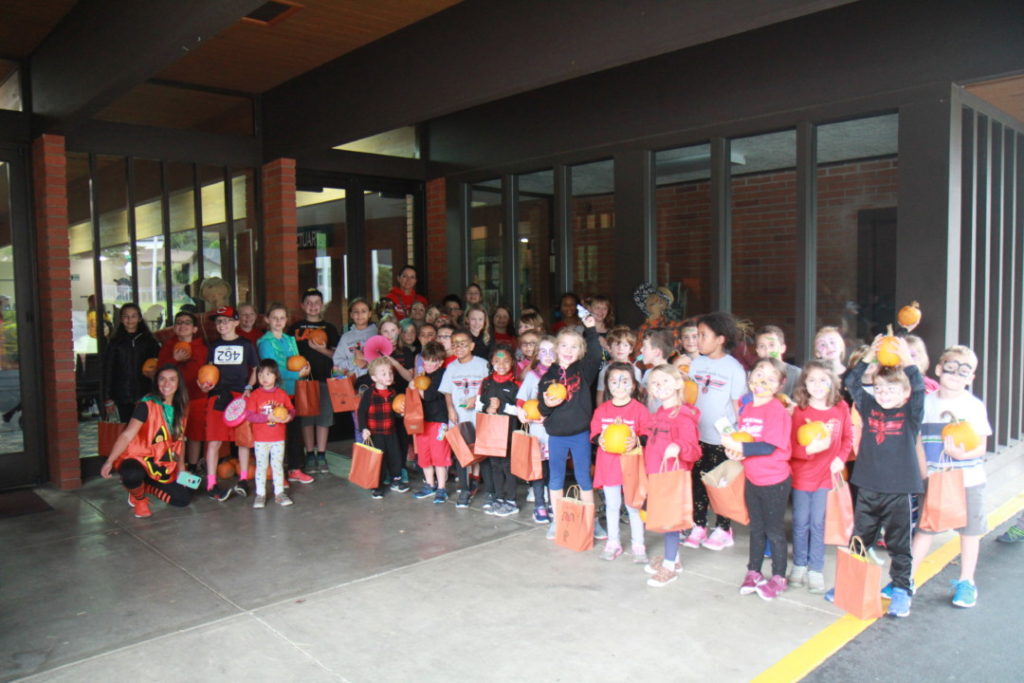
-
Día del niño pumpkin gifts
-
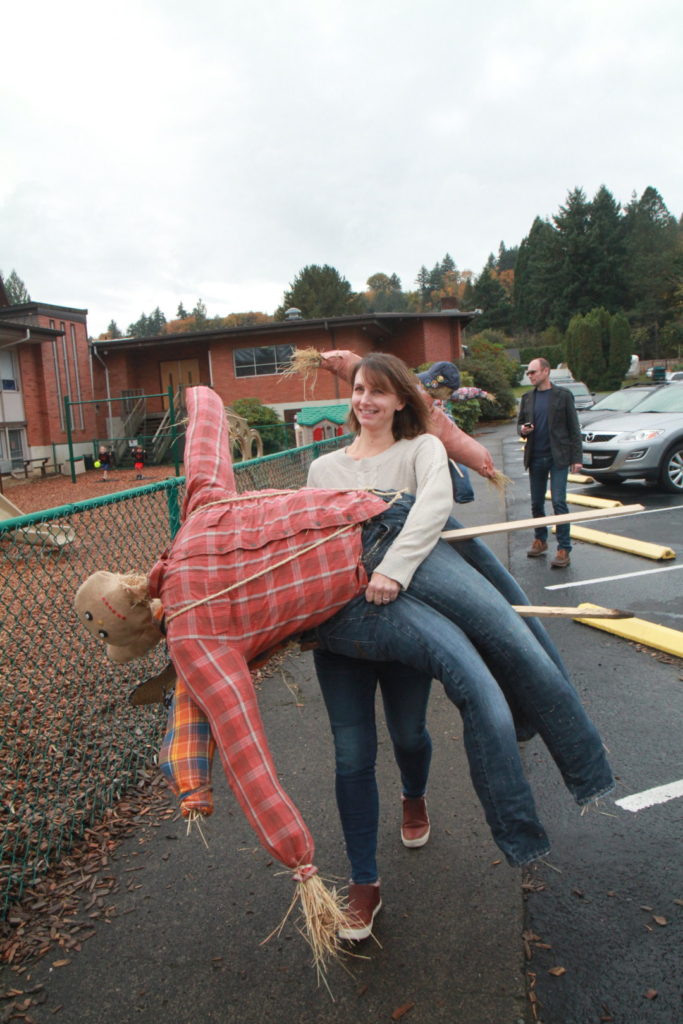
-
Scarecrows were made by K-5 classes. Thank you Bridget and Amber!
-
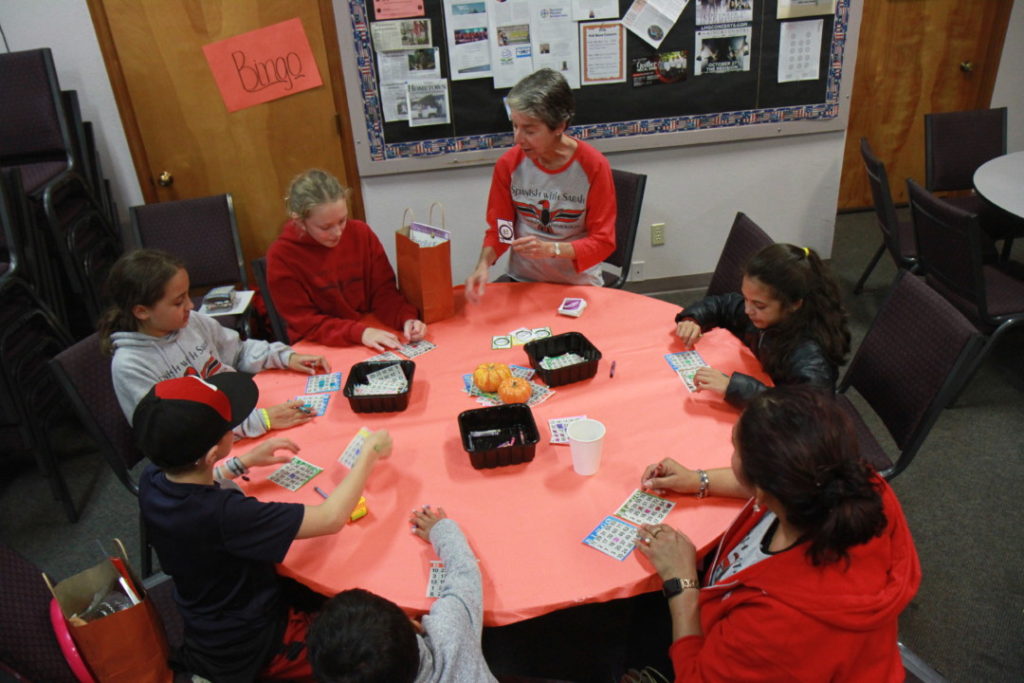
-
BINGO with Ms. Laura
-
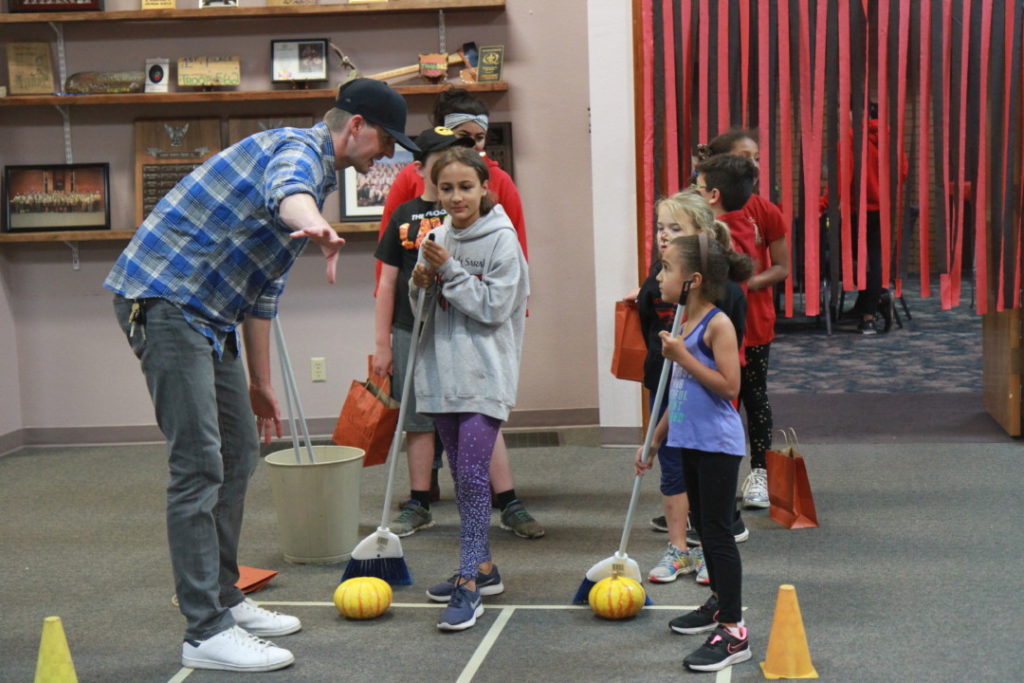
-
Parents led all games.
-
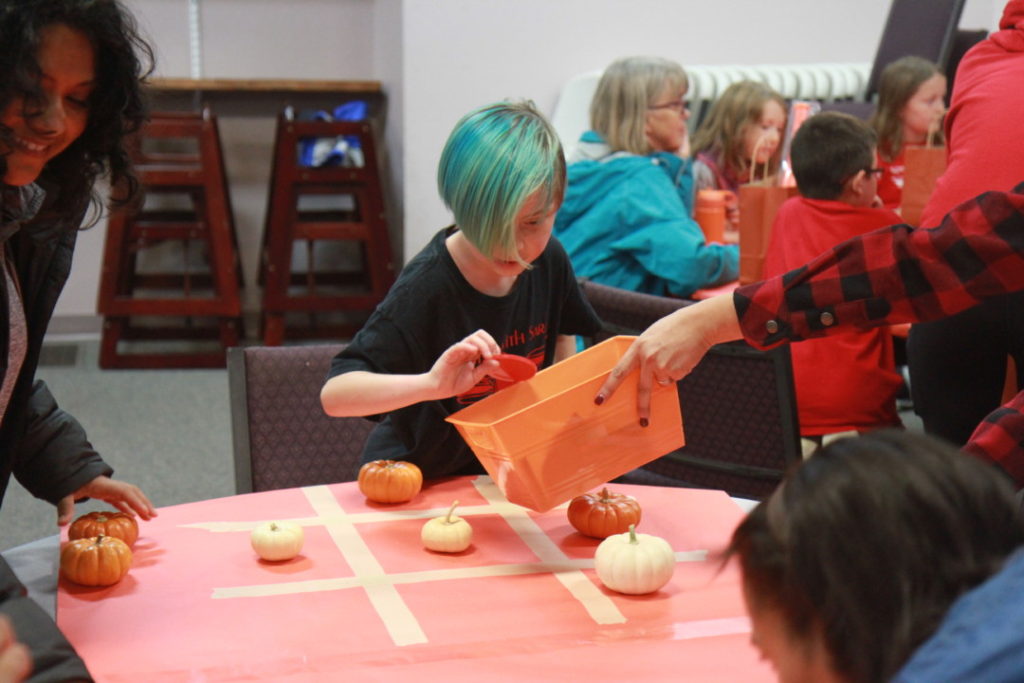
-
Pumpkin Tic-tac-toe
-
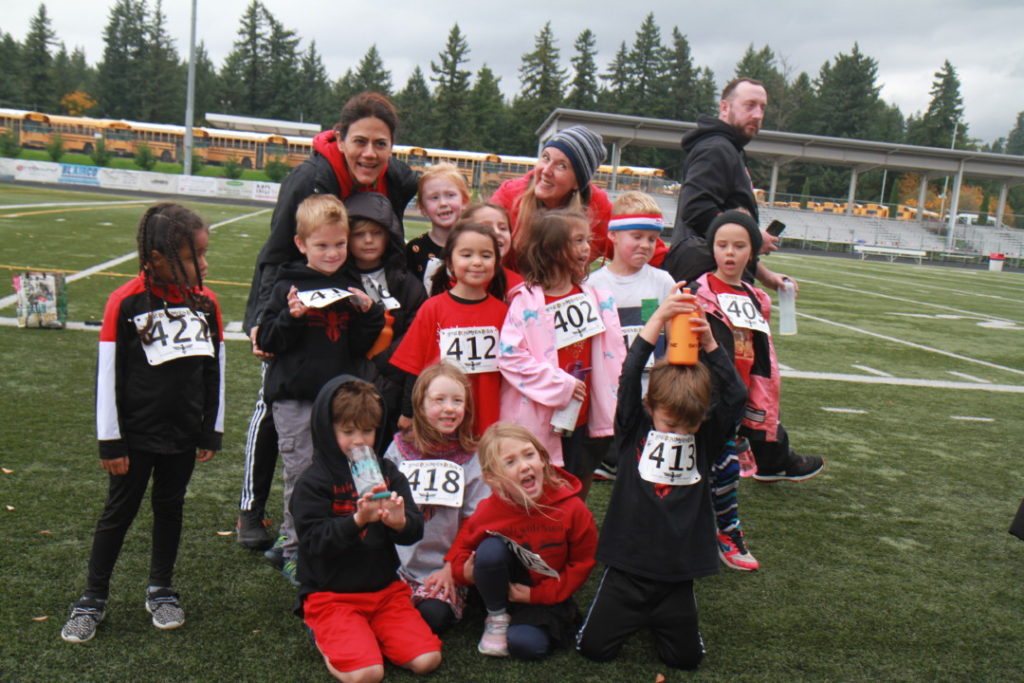
-
Kindergarten
-

-
Preschool
-

-
4th/5th Grade
-
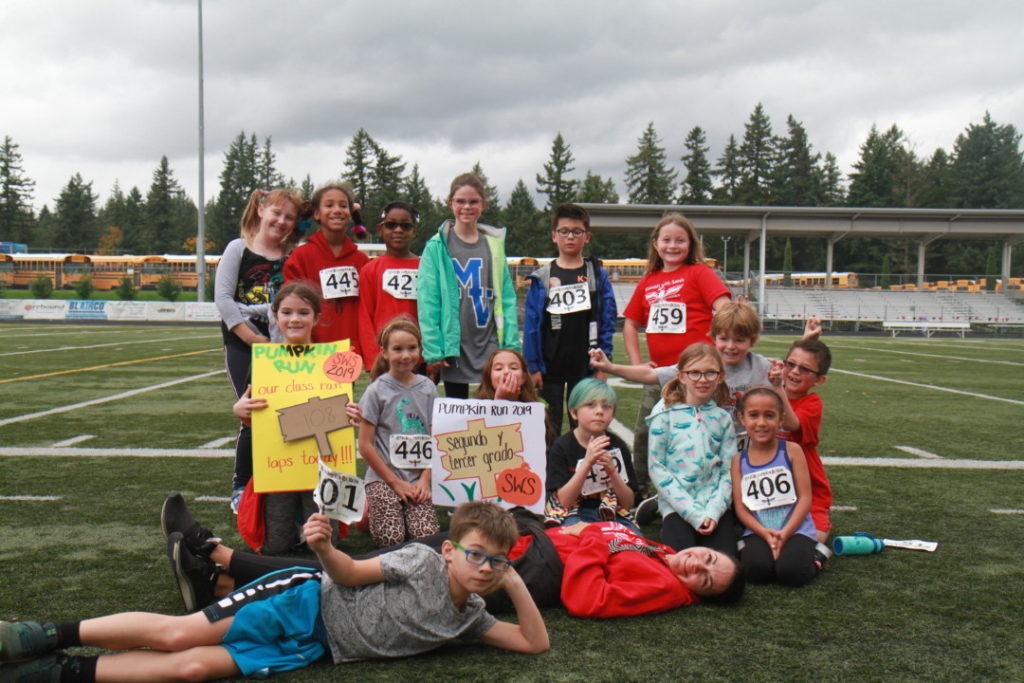
-
2nd/3rd Grade
-
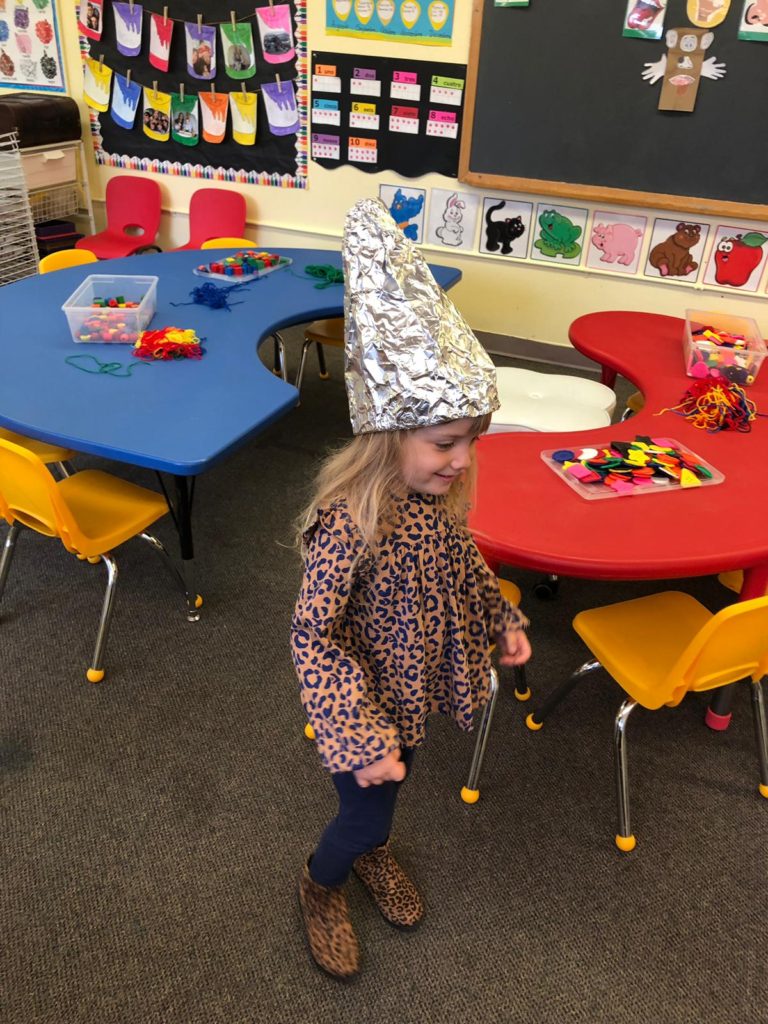
-
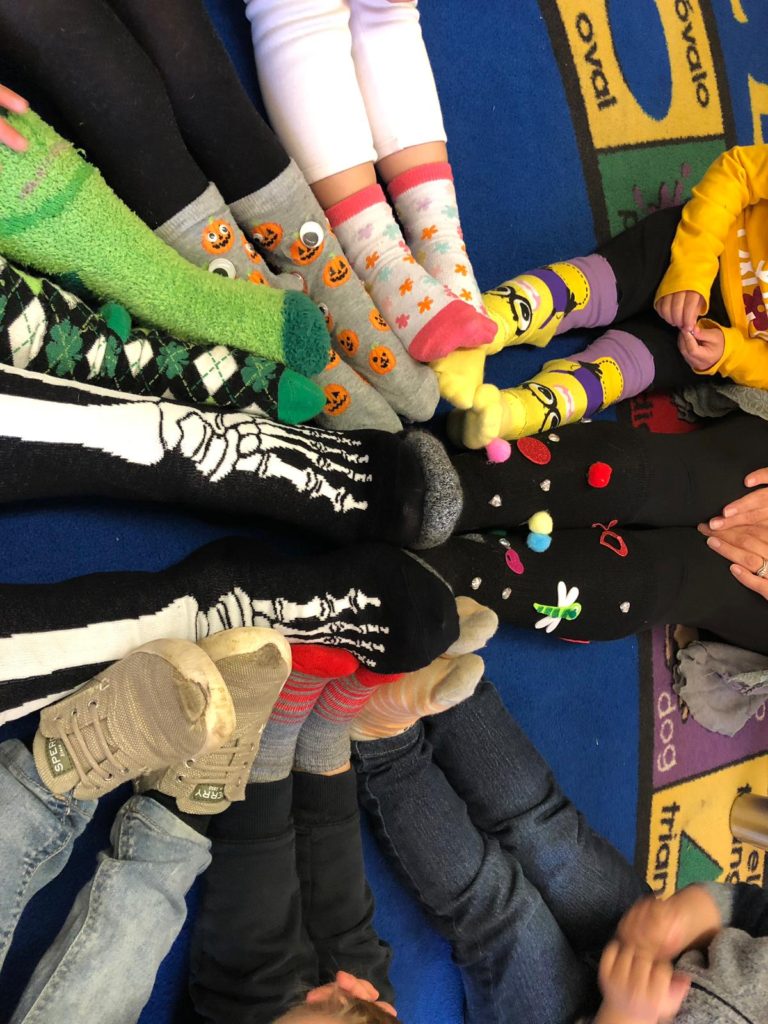
-
Sock day!
-
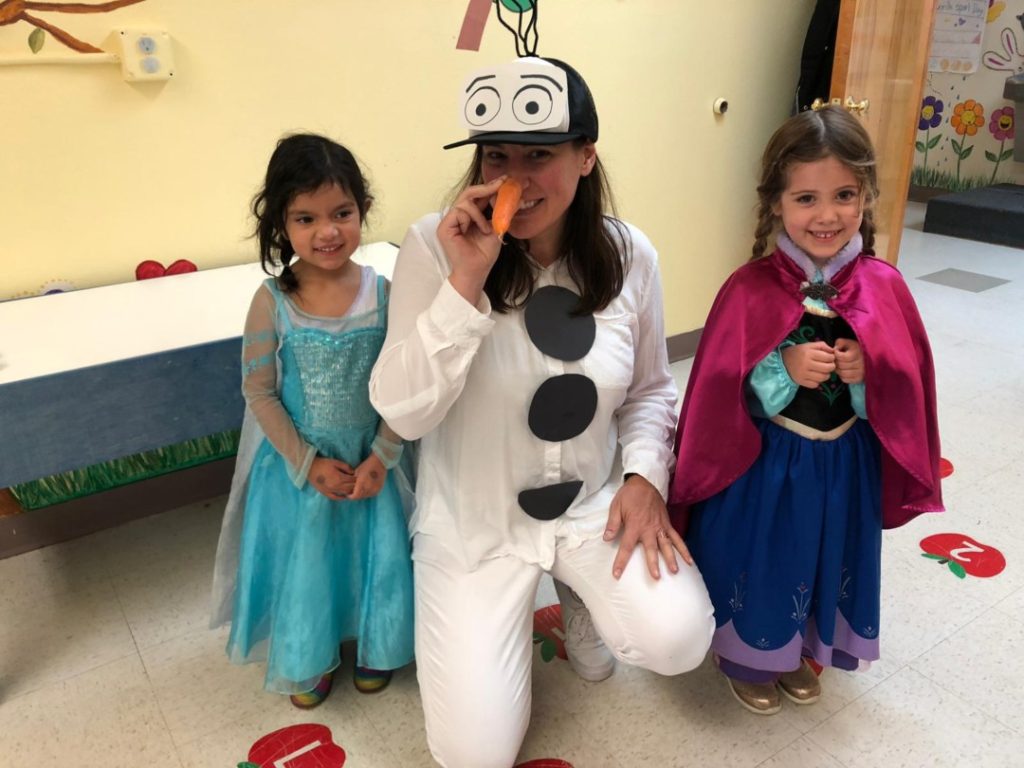
-
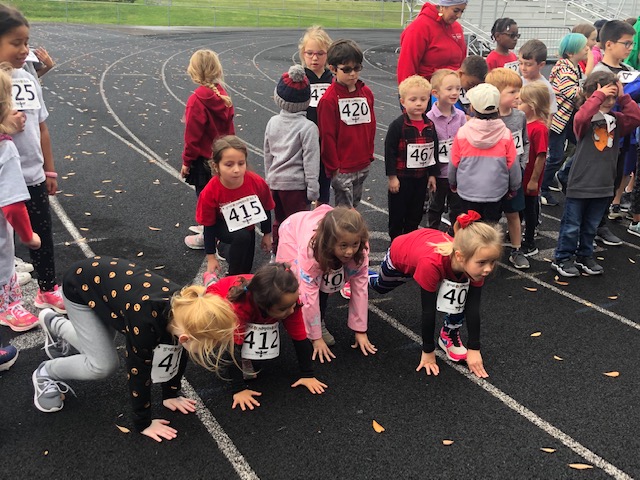
-
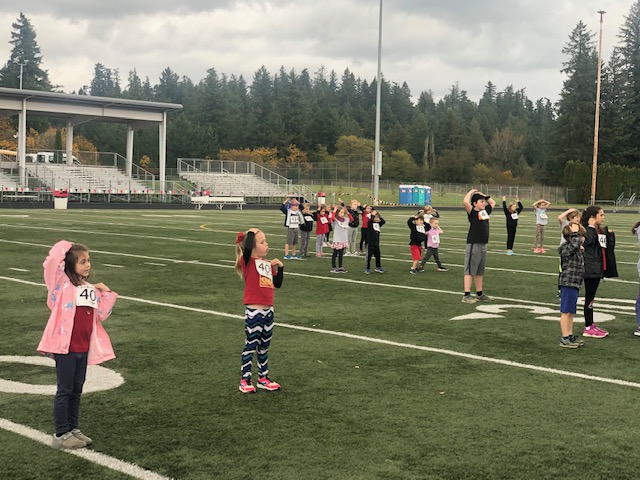
-
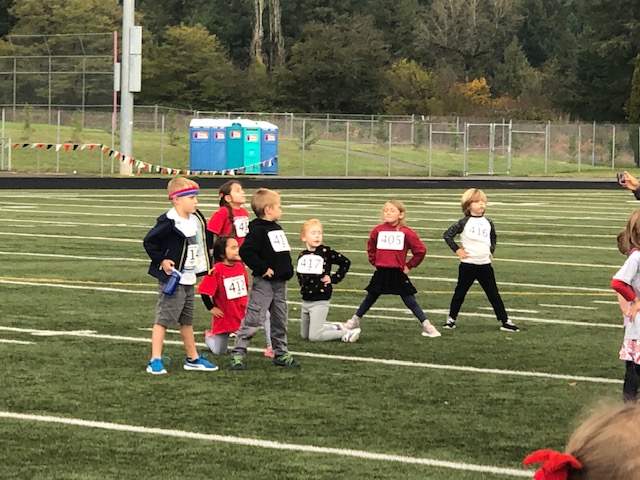
-
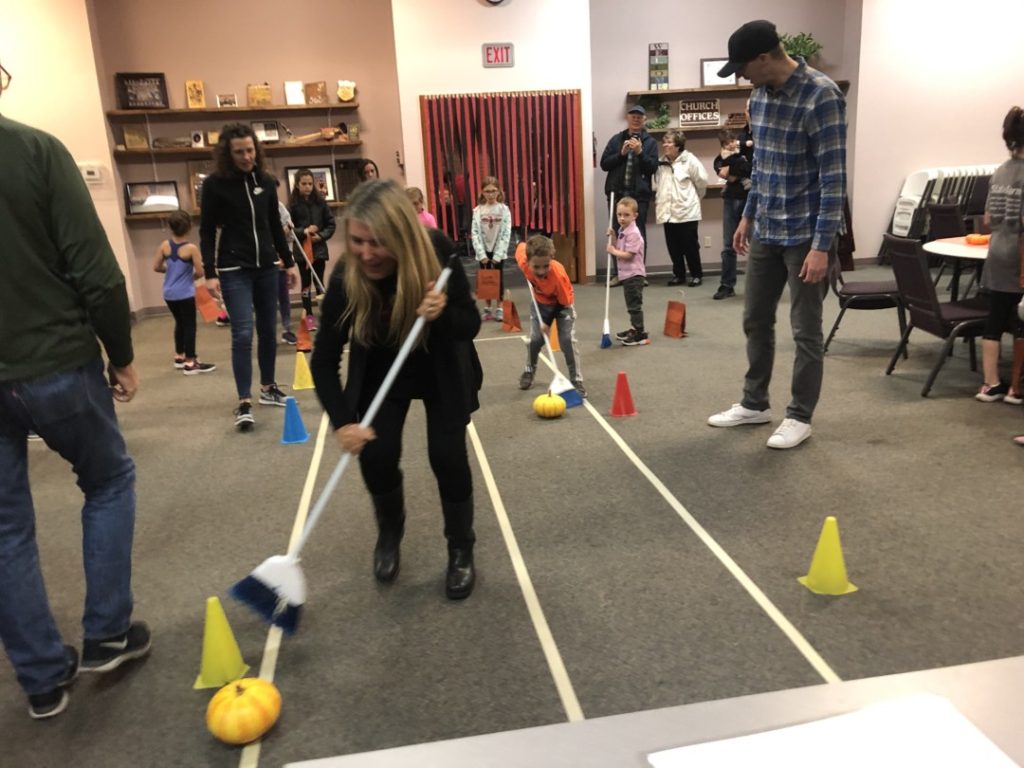
by Marci & Ivary | Oct 19, 2019 | First Grade News
La Lectura
 This week we read Masticar, comer: Lo que comen los animales. Our objectives were:
This week we read Masticar, comer: Lo que comen los animales. Our objectives were:
- identify letters within the story
- discuss connections between the story and the world
- practice identifying the number of syllables within a word
- using the comprehension skill main idea and details
Las matemáticas
This week we began working with Subtraction within 10. Our objectives were:
- take away to subtract
- count on to subtract
- count back to subtract
- use number bonds to subtract
Science
This week in our Astronomy domain we continued to work on the solar system flip books and read about our solar system.
Our weekly objectives were to:
• identify Earth as a planet and our home
• classify the sun as a star
• understand that Earth orbits the Sun
• explain that our solar system includes the sun and the planets that orbit around it
• indicate that there are eight planets (Mercury, Venus, Earth, Mars, Jupiter, Saturn, Uranus, and Neptune)
• understand that Pluto has been reclassified as a dwarf planet
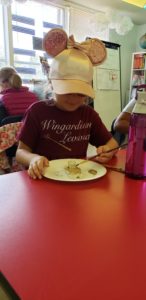
Painting our sphinx.
History & Geography
This week in our Ancient Egyptian studies the class we learned about King Tutankhamun and the discovery of his tomb. The class had fun being archaeologist, excavating chocolate chip artifacts from cookies.
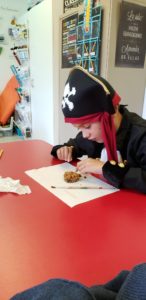
… Archaeologist”
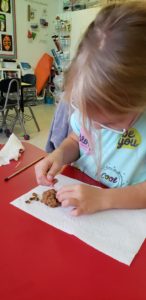
“Culinary…
Our weekly objectives were to
• locate Egypt on a world map or globe, and identify it as part of Africa
• describe key components of a civilization
• identify Tutankhamun as a pharaoh of ancient Egypt
• explain the significance of Tutankhamun
• understand that much of what we know about ancient Egypt is because of the work of archaeologists
English Sight Words of the Week
I, if, in, into, is, it, like, long
by Jill & Sarah | Oct 19, 2019 | 2nd/3rd Grade News

La Lectura
Students received their new spelling list. The spelling test will be next Friday, October 25th. We created a class book with this list of spelling words. Each student illustrated and wrote a sentence for one word and then we combined them and made copies. (Some kiddos needed to write a little darker for the copier to pick up so we traced over words.)
Students also received a new reader this week. They should be reading in Spanish on a nightly basis but I know this can sometimes be difficult. To help with this, I have created class logins on kidsa-z.com. They can read a book aloud, while the computer records their reading. I will be able to listen to each student, keep a running record, ask comprehension questions, and move them along to the appropriate level. We will be creating a class chart for progress minutes to help encourage them to read in Spanish. (Any Spanish reading counts towards this.) I’m pretty excited about this, as finding something new to read in Spanish has been a continual question from families. I sent home a parent information sheet on Thursday. If you would like to receive email updates, please fill out the bottom of the form and return it.
We also did some identification of topic sentences in paragraphs and discussed how this is important when reading AND when writing.
We added the letter J to our cursive skills.
Reading
On Thursday I sent home a new source for Spanish reading: www.kidsa-z.com Your child has the same username and password as Prodigy. This site has hundreds and hundreds of Spanish (and English) readers. Students took a placement test on Thursday and will be placed at the correct level as I work through them this weekend. This is a GREAT online resource because:
- It puts hundreds of Spanish (and English) books in your child’s hands.
- It allows your child to read at the appropriate level.
- It records your child’s reading so I can listen and keep a running record to help place them in the appropriate level.
- It asks comprehension questions, to make sure your child is understanding what they are reading.
Please let me know if you have any questions about this. (It is not mandatory to use this online system but is useful to help get that nightly Spanish reading in.)
Las matemáticas
This week we jumped right into our new math unit: Addition to 10,000. Students showed great understanding of addition with and without regrouping. To help them be more efficient mathematicians we have paused our multiplication timed tests and started doing addition timed tests. If your child is not passing their addition timed tests each day please be sure to get out the flashcards. Addition facts should be automatic. Students are given 2 minutes to complete 50 basic addition facts each day. Their addition skills directly affect their ability to move smoothly through our math lessons.
Science
Our science objectives this week were to:
- Describe and/or review seven of the systems of the human body
- Explain that the human body includes the following systems and identify the function of each: skeletal, muscular, and nervous
- Identify cells as the basic building blocks of all living things and explain that most cells are too small to be seen without a microscope
- Explain the relationship between cells, tissues, organs, and systems
- Explain that each system is made up of different types of cells (bone cells, muscle cells, nerve cells, blood cells, etc.)
- Recall there are 206 bones in the human body
- Identify examples of axial bones and explain their functions
- Explain briefly the composition of bones
History and Geography
This week we started a new unit: The Ancient Roman Civilization. Our objectives were to:
- Explain why Rome was considered a civilization
- Identify and locate on a map the following areas: Atlantic Ocean, Mediterranean Sea, Black Sea, Aegean Sea, Europe, Italy, Rome, Pompeii, Mount vesuvius, Greece, France, Spain, England, Africa, Asia, and Turkey
- Locate the Bosporous Strait and the Strait of Gibraltar, and explain the purpose of these waterways
- Identify Rome as the capital of present-day Italy
- Identify the country of Italy as a peninsula
- Define the terms BC/BCE and AD/CE
- Describe how the work of archaeologists has helped us gain info about the ancient Roman civilization
- Identify some of the contributions of the ancient Roman civilization
by Jackie & Marci | Oct 19, 2019 | Kindergarten News

La Lectura
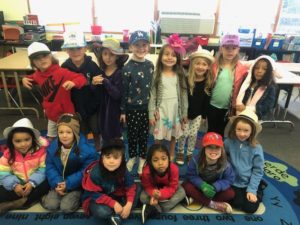 We had a week full of fun with our Spirit Week, Pumpkin Fun Run and “Día del niño” (Children’s Day). The children were very happy and enthusiastic and took this opportunity to encourage them to talk about their clothes throughout spirit week. They told their experiences on how they chose their hats and socks and why they liked them. They also commented about their favorite Disney movie. The little ones had fun times and they also had the chance to use part of their growing Spanish vocabulary to share with the class.
We had a week full of fun with our Spirit Week, Pumpkin Fun Run and “Día del niño” (Children’s Day). The children were very happy and enthusiastic and took this opportunity to encourage them to talk about their clothes throughout spirit week. They told their experiences on how they chose their hats and socks and why they liked them. They also commented about their favorite Disney movie. The little ones had fun times and they also had the chance to use part of their growing Spanish vocabulary to share with the class.
The students learned new letters: g, ch, n, v, practicing the stroke and sounds of those letters. The words of the week were: es (is) son (are). The children contributed ideas to make sentences using those words and then wrote them in their notebooks.
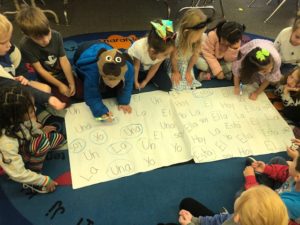 We had an activity where two teams were formed. I called out one of the words of the week and they got the chance to find the word on the big paper lying down on the floor. Once they found the word they made a circle around it. The first children to find the written word correctly received a sticker or stamp. This exercise makes the link from a spoken word and its written representation, a great exercise to learn the words of the week.
We had an activity where two teams were formed. I called out one of the words of the week and they got the chance to find the word on the big paper lying down on the floor. Once they found the word they made a circle around it. The first children to find the written word correctly received a sticker or stamp. This exercise makes the link from a spoken word and its written representation, a great exercise to learn the words of the week.
We continued reading Annabell Swift Parvula book and using some words and concepts related to the book. We introduced students to words that rhyme and learned more vocabulary in Spanish. It’s great to introduce the use of rhyming words as a way to build vocabulary. Rhyming words are an enjoyable way for kindergartners to learn words, as well as pay more attention on how they sound, this exercise gives them a rest on spelling or reading. Example:
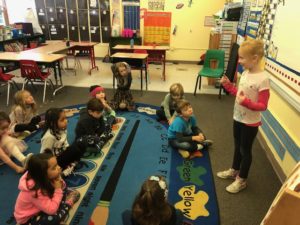 Pizarrón (Whiteboard) – Canción (song)
Pizarrón (Whiteboard) – Canción (song)
Limón (lemon)- Crayón (crayon)
Casa (house)- Masa(Mass)
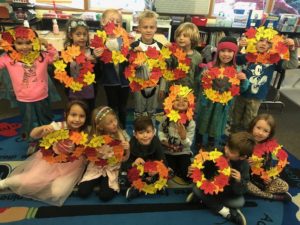 The craft of the week was to make an autumn wreath formed with leaves for capital and lower letters, where the children had to match the letter that corresponds.
The craft of the week was to make an autumn wreath formed with leaves for capital and lower letters, where the children had to match the letter that corresponds.
Las matemáticas
We continued working with the numbers of 25 to 28, quantities, strokes, odd and even, and we practiced counting one by one until one hundred. This week we started to practice counting in multiples 5, and 10. We practiced numbers and sums with dominoes, using their hands, tallies and lego blocks in order to continue practicing to introduce them to the sums.
Science
This week we learned about modern day farming; how vehicles and technology have improved farming productivity. The class began to work on a counting farm book and read several trade books on farming.
Our weekly objectives were to:
• describe the farmers job
• explain by Farmers grow crops
• understand that vehicles and technology have improved farm production so that fewer farms produce a greater amount of crops.
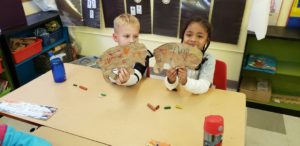
Painting on “buffalo skin”
History & Geography
This week in our unit: The First Inhabitants of North America, we read about the plains Native American tribe, the Sioux. The class worked on a chart identifying shelter, food, clothing, and regional characteristics of the Sioux, and then compared these to that of their own equivalent.
Our weekly objectives were to:
• understand that Native Americans were the first inhabitants of North America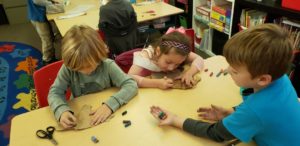
• explain that there are many tribes of Native American
• Identify some unique characteristics of the Sioux.
• understand that the buffalo was a sacred animal to the Sioux
English Sight Words of the Week
white, that, this
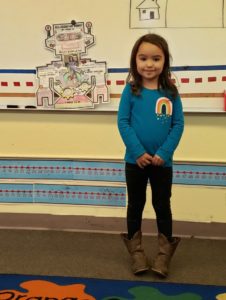
Student of the month

 This week we continued to learn about the Age of Exploration. Our objectives were:
This week we continued to learn about the Age of Exploration. Our objectives were: This
This week we began learning about Fractions and Mixed Numbers. Our objectives were:
week we began learning about Fractions and Mixed Numbers. Our objectives were:




































































